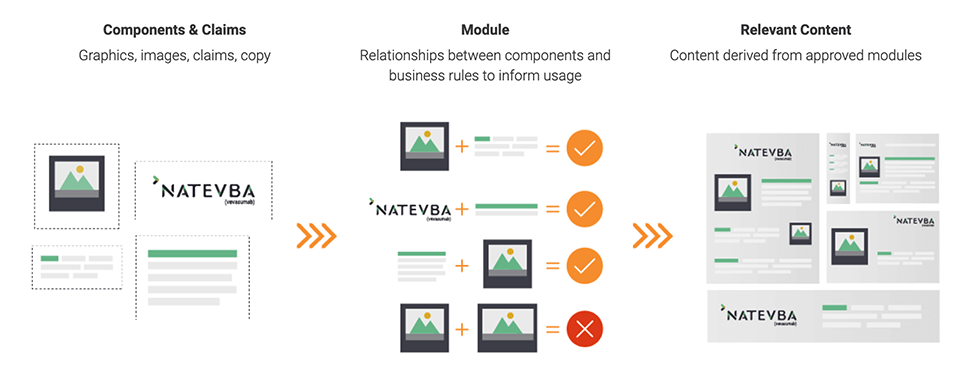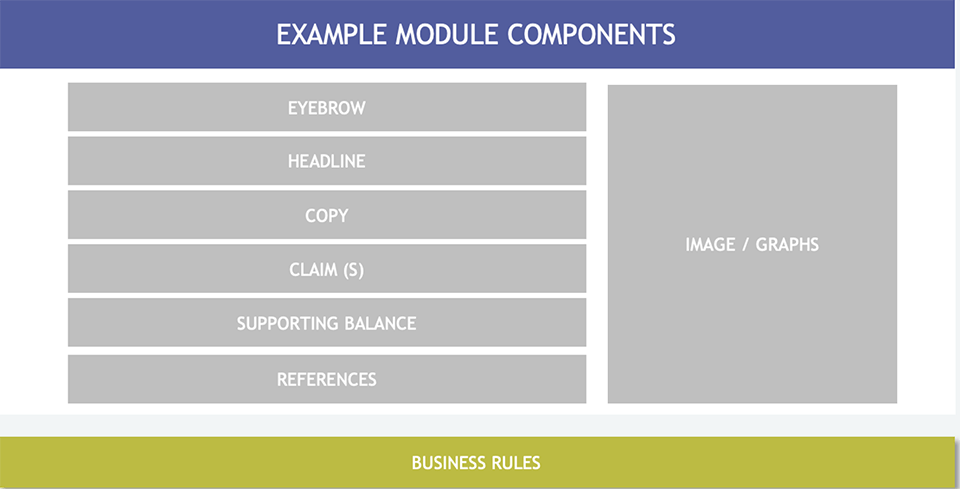Blog
Why Sanofi Is Going All-in with Modular Content
Apr 26, 2022 | Craig McGettigan and Ryan Rosenberg
Apr 26, 2022 | Craig McGettigan and Ryan Rosenberg
Omnichannel engagement may have only recently entered pharma’s commercial repertoire, but it couldn’t have happened at a better time. The industry’s widespread adoption of CRM has created the perfect opportunity to finally deliver on the promise of omnichannel.
Realizing this, our leadership team at Sanofi rolled out a companywide omnichannel initiative in early 2021, focused on driving more connected, personalized HCP experiences. As local teams began discussing plans for operationalizing omnichannel, however, we realized that our approach to content would need to evolve to meet the need for more rapidly created, personalized—and compliant—assets.
Here’s why the U.S. General Medicines team at Sanofi decided to go all-in with modular content and how it’s laying the foundation for faster, smarter content creation.
Improving content efficiency
The biggest bottleneck pharma companies face when creating content is often the review process. In fact, according to Veeva Pulse data, the industry takes three weeks, on average, to deliver content to market. Typical delays happen while content is in draft state (spending six days before review), followed by the actual review process itself, which takes an average of 15 days.1
So rather than require a full medical, legal, regulatory (MLR) review every time a new asset is created, our plan is to build modules of content (typically surrounding a claim or very important piece of information) that can go through MLR review independently.
New assets would leverage those pre-approved content modules, so that by the time they go to the MLR team for review, a large portion of the content would already be signed off on. This means faster reviews, fewer mistakes, and a smoother, less burdensome process for the MLR team.

Modular content breaks down assets into pre-approved content blocks, or “modules,” for use across audiences and channels.
Establishing a shared understanding
To kick off our modular content initiative, we started by clearly defining our goals for the project as well as what exactly we mean by the term “modular content.” Some people were confusing it with variable content—which, unlike modular content, is channel-specific—so it was important to align around a common understanding.
At Sanofi, modular content is defined as content that’s been pre-approved in Veeva Vault PromoMats with its own material number that can be referenced along with accompanying business rules of how to use that piece of content.
With our why and what defined, it was then time to get buy-in from our internal and agency partners. Education played a critical role in getting people on board. As part of this effort, we created a white paper on the vision and goals behind modular content, a video series explaining what modular content is, and real-world examples and mockups of what could be modularized. We also held multiple working sessions with our MLR colleagues to ensure they were fully involved in the process.

Each content module includes associated copy, claims, references, and images that get pre-approved for reuse across assets.
Templates and training
Meanwhile, we also started building out the foundational tools that would enable faster content creation, starting with channel-specific templates and content standards for agencies to work from. These templates would then get turned into reusable building blocks (i.e., modular content) that get stored in a centralized content repository.
In addition to templates, we’re establishing libraries of core claims—pre-approved statements about Sanofi products that are substantiated by references—in Vault PromoMats. Claims are a key building block for content modules, so building this claims library now will only accelerate our move to modular.
Outside of modular content, another way we’re trying to improve MLR efficiency is through analysis of the team’s comments in Vault PromoMats. Veeva is helping us identify the common mistakes our agencies are making, so we can flag those moving forward with education and training around best practices and pitfalls to avoid. We’re starting by extracting comments for three brands, using those initial insights to come up with a metadata structure that makes comment analysis easier in the future.
Tips for success
While Sanofi’s modular content journey is still in its early stages, our path toward improved content efficiency is clear. Once the tools and technology are in place to support our broader vision, we expect to see reduced time to market and agency spend as a result of less error and rework. We’re also confident that there will be significantly less friction for all stakeholders in the content creation process.
Our advice for other companies looking to launch similar initiatives is to start by clearly defining what modular content means for your company. The term can mean different things to different people, so you want to make sure that all key players are on the same page—not only in terms of goals and vision but in how you’ll get there as well.
Ensuring this group is on board and kept in the loop on progress is critical to success. Instead of rushing through the change management process, take the time to break out the work in bite-size chunks and start by driving change on a smaller scale (within a particular brand, for example) and expand your efforts based on initial learnings.
It also helps to partner with someone who’s successfully implemented modular content before. For us, that partner was Veeva. While the company’s technology is certainly important to the project’s success, it’s the expertise and guidance we’ve received that’s truly made a difference in how quickly we’ve been able to move forward.
Ultimately, omnichannel is all about putting our HCPs (not our products) at the center of what we do. It’s about making sure they get the content and data they need at the right time, in the right channel, and on the right device to deliver the critical care and treatments that patients deserve.
To learn how a modular approach can transform your omnichannel strategy, read this e-book.
1 “2021 Veeva Pulse Content Metrics Report<,” Veeva, 2021.